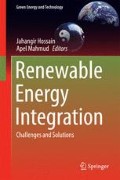Abstract
A novel aggregated model for wind farms consisting of wind turbines equipped with doubly fed induction generators (DFIG) is proposed in this paper. In the proposed model, a mechanical torque compensating factor (MTCF) is integrated into a full aggregated wind farm model to deal with the nonlinearity of wind turbines in the partial load region and to make it behave as closely as possible to a complete model of the wind farm. The MTCF is initially constructed to approximate a Gaussian function by a fuzzy logic method and optimized on a trial and error basis to achieve less than 10% discrepancy between the proposed aggregated model and the complete model. Then, a large scale offshore wind farm comprising 72 DFIG wind turbines is used to verify the effectiveness of the proposed aggregated model. The simulation results show that the proposed model is able to approximate collective dynamic responses at the point of common coupling with significant reduction in the simulation computation time.
Access this chapter
Tax calculation will be finalised at checkout
Purchases are for personal use only
References
Executive Summary (2011) World wind energy report 2011. http://www.wwindea.org/home/index.php. Accessed 15 Nov 2011
[2] Li L, Jing Z, Yihan Y (2009) Comparison of pitch angle control models of wind farm for power system analysis. In: IEEE power and energy society general meeting, Calgary, pp 1-7 July 2009
Rodriguez-Amenedo JL, Arnalte S, Burgos JC (2002) Automatic generation control of a wind farm with variable speed wind turbines. IEEE Trans Energy Convers 17:279–284
Tapia A, Tapia G, Ostolaza JX, Saenz JR, Criado R, Berasategui JL (2001) Reactive power control of a wind farm made up with doubly fed induction generators. In: IEEE Power Tech Proceedings, Porto, p 6, September 2001
Feijóo A, Cidrás J, Carrillo C (2000) A third order model for the doubly-fed induction machine. Elect Power Syst Res 56:121–127
Ekanayake JB, Holdsworth L, XueGuang W, Jenkins N (2003) Dynamic modeling of doubly fed induction generator wind turbines. IEEE Trans Power Syst 18:803–809
Nunes MVA, Lopes JAP, Zurn HH, Bezerra UH, Almeida RG (2004) Influence of the variable-speed wind generators in transient stability margin of the conventional generators integrated in electrical grids. IEEE Trans Energy Convers 19:692–701
Akhmatov V, Knudsen H (2002) An aggregate model of a grid-connected, large-scale, offshore wind farm for power stability investigations—importance of windmill mechanical system. Int J Electr Power Energy Syst 24:709–717
Usaola J, Ledesma P, Rodriguez JM, Fernandez JL, Beato D, Iturbe R et al. (2003) Transient stability studies in grids with great wind power penetration. Modelling issues and operation requirements. In: IEEE power engineering society general meeting, Toronto, p 1541, July 2003
Ledesma P, Usaola J, Rodríguez JL (2003) Transient stability of a fixed speed wind farm. Renewable Energy 28:1341–1355
Slootweg JG, Kling WL (2003) Aggregated modelling of wind parks in power system dynamics simulations. In: IEEE power tech conference proceedings, Bologna, p 6, June 2003
Fernández LM, García CA, Saenz JR, Jurado F (2009) Equivalent models of wind farms by using aggregated wind turbines and equivalent winds. Energy Convers Manage 50:691–704
Fernández LM, Jurado F, Saenz JR (2008) Aggregated dynamic model for wind farms with doubly fed induction generator wind turbines. Renewable Energy 33:129–140
Poller M, Achilles S (2003) Aggregated wind park models for analyzing power system dynamics. In: Proceedings of the international workshop on large scale integration of wind power and transmission networks for offshore wind farms, Billund, Oct 2003
Perdana A, Carlson O, Persson J (2004) Dynamic response of grid-connected wind turbine with doubly fed induction generator during disturbances. In: Proceedings of the IEEE Nordic workshop on power and industrial electronics, Trondheim, June 2004
Sedaghat A, Mirhosseini M (2012) Aerodynamic design of a 300 kW horizontal axis wind turbine for province of Semnan. Enerergy Convers Manage 63:87–94
García-Gracia M, Comech MP, Sallán J, Llombart A (2008) Modelling wind farms for grid disturbance studies. Renewable Energy 33:2109–2121
Ghennam T, Berkouk EM, Francois B (2009) Modeling and control of a Doubly Fed Induction Generator (DFIG) based wind conversion system. In: International conference on power engineering, energy and electrical drives, Lisbon, March 2009
Wei Q, Venayagamoorthy GK, Harley RG (2009) Real-Time implementation of a STATCOM on a wind farm equipped with doubly fed induction generators. IEEE Trans Ind Appl 45:98–107
Salman SK, Badrzadeh B (2004) New approach for modelling doubly-fed induction generator (DFIG) for grid-connection studies. European wind energy conference and exhibition, London, November 2004
SimPowerSystems (2010) – model and simulate electrical power systems. User’s guide. Natick (MA): The Mathworks Inc
Voelker DH (2001) Statistics. John Wiley and Sons Inc, New York
Senjyu T, Sakamoto R, Urasaki N, Funabashi T, Fujita H, Sekine H (2006) Output power leveling of wind turbine generator for all operating regions by pitch angle control. IEEE Trans Energy Convers 21:467–475
Slootweg JG (2003) Wind power: modelling and impact on power system dynamics. Dissertation, Delft University of Technology
Engelhardt S, Erlich I, Feltes C, Kretschmann J, Shewarega F (2011) Reactive power capability of wind turbines based on doubly fed induction generators. IEEE Trans Energy Convers 26:364–372
Magnusson M, Smedman AS (1999) Air flow behind wind turbines. J Wind Eng Ind Aerodyn 80:169–189
Rudion K (2008) Aggregated modelling of wind farms. Dissertation, Otto-von-Guericke University
Perdana A (2008) Dynamic models of wind turbines. Dissertation, Chalmers University of Technology
Trilla L, Gomis-Bellmunt O, Junyent-Ferre A, Mata M, Sanchez Navarro J, Sudria-Andreu A (2011) Modeling and validation of DFIG 3-MW wind turbine using field test data of balanced and unbalanced voltage sags. IEEE Trans Sustain Energy 2:509–519
Author information
Authors and Affiliations
Corresponding author
Editor information
Editors and Affiliations
Rights and permissions
Copyright information
© 2014 Springer Science+Business Media Singapore
About this chapter
Cite this chapter
Chowdhury, M.A. (2014). A Novel Aggregation Technique Using Mechanical Torque Compensating Factor for DFIG Wind Farms. In: Hossain, J., Mahmud, A. (eds) Renewable Energy Integration. Green Energy and Technology. Springer, Singapore. https://doi.org/10.1007/978-981-4585-27-9_13
Download citation
DOI: https://doi.org/10.1007/978-981-4585-27-9_13
Published:
Publisher Name: Springer, Singapore
Print ISBN: 978-981-4585-26-2
Online ISBN: 978-981-4585-27-9
eBook Packages: EnergyEnergy (R0)

